Trichophyton is a dermatophyte filamentous fungus. It is a common cause superficial infections such as onychomycosis and various kinds of tinea, although it can occasionally become invasive.
The taxonomy of Trichophyton spp. and other dermatophytic fungi has recently been revised (de Hoog et al, 2017). There are 16 accepted species in 4 series or complexes of which T. rubrum and T. mentagrophytes are the most common. T. rubrum and T. violaceum are considered similar as part of the one complex. Species within the T. mentagrophytes series include T. mentagrophytes, T. tonsurans, T. interdigitale and T. schoenleinii. A new clade within the T. mentagrophytes complex has emerged in India, with high levels of terbinafine resistance (Singh, 2019).

Factsheets
Trichophyton mentagrophytes
| NAMES Trichophyton mentagrophytes |
| NATURAL HABITAT Humans and occasionally animals such as cats, dogs and rats. |
| GEOGRAPHY Worldwide |
| DISEASES Tinea pedis, Tinea corporis, Tinea cruris, onychomycosis and occasionally Tinea capitis. |
| FREQUENCY The second most common cause of dermatophytosis. |
| CULTURE Colonies are white or cream, with a yellow pigment and the surface has a powdery appearance. The underside of the plate is orange to yellow. Microscopy shows abundant conidia, either rounded or tear shaped. Macroconidia are usually absent when the strain has been isolated from humans, and can form fine-walled cigar shapes. Biosafety level 2 |
| ANTIFUNGAL RESISTANCE Terbinafine would be the optimal treatment, although increasing instances of resistance are described, especially in India. Other antifungals like ketoconazole, clotrimazole, itraconazole, naphthalene and amorolfine are also active. This species is generally resistant to fluconazole. Patients failing terbinafine usually respond to high dose (i.e. 400 mg daily) itraconazole. |
| INDUSTRIAL USES None |
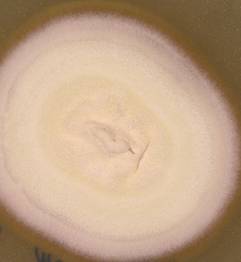
Culture of Trichophyton interdigitale 
Microscopical appearance of T. interdigitale 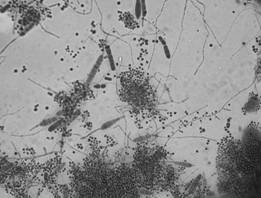
Microscopical appearance of T. interdigitale

Trichophyton rubrum
| NAMES Trichophyton rubrum Granular type and downy type. |
| NATURAL HABITAT Anthropophilic dermatophyte: infectious lesions (tinea); animals very rarely infected.T. rubrum is an obligate human pathogen not found in the environment. |
| GEOGRAPHY Worldwide. Granular strain is a frequent cause of tinea corporis in South East Asia and in Aborigines living in the Northern Territory of Australia. American troops returning from the Vietnam War brought this strain back with them and refugees from South East Asia also facilitated the global spread. The downy type evolved from the granular strain by establishing a niche on the feet (tinea pedis), when the latter was imported into Europe about 100 years ago. |
| DISEASES Tinea of the groin, glabrous skin, feet, hands, and the nails. Tinea cruris, tinea corporis, tinea pedis, tinea manuum, and onychomycosis. The scalp is very rarely infected. |
| PREVALENCE Most widely distributed dermatophyte of man. |
| CULTURE Biosafety level 2 |
| ANTIFUNGAL RESISTANCE Ketoconazole, clotrimazole, itraconazole, fluconazole, terbinafine, naftifine, and amorolfine are in general active in vitro against T. rubrum. Terbinafine resistance has recently emerged and reference susceptibility testing methods are now published, although Etest strips can be used. |
| INDUSTRIAL USES None |
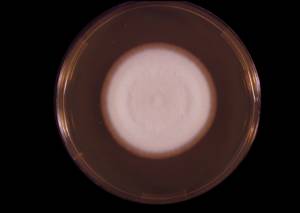
Trichophyton rubrum downy type 
C haracteristic deep wine-red reverse pigment 
Microscopy of a culture of T. rubrum 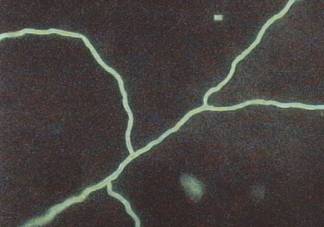
Direct microscopy of T. rubrum hyphae in a skin sample

Trichophyton indotineae
| NAMES Trichophyton indotineae (formerly T. mentagrophytes) |
| NATURAL HABITAT Dermatophyte infections are particularly common in tropical and subtropical countries, where temperature and humidity are high most of the year, enhancing fungal infection. Thought to have originated in burrowing animals. |
| GEOGRAPHY Thought to have originated on the Indian sub-continent. Cases have been reported in Japan, but these are from the Indian and Nepalese nationals (Kano et al, 2020). First cases in Europe have recently been reported (Jabet et al, 2022). Cases also reported in Cambodia, Iran, Bahrain, Switzerland, Greece, Finland, and Germany and is thought introduced by inhabitants or visitors from the Indian subcontinent. The origin of T. indotineae, which currently causes a significant public health problem, is zoonotic, and its emergence is likely due to widespread misuse of topical antifungals, especially terbinafine. The cause of this outbreak has been speculated to be driven by the uncontrolled over-the-counter sale of topical cream containing both steroids, antifungals and antibiotics. |
| DISEASES extensive dermatophytosis is characterised by tinea cruris, tinea corporis, or both, of the glabrous skin. Extensive and inflammatory tinea corporis (ringworm) is a hallmark of infection. |
| PREVALENCE 20 to 25 percent of the global populations are affected by dermatophyte infections. Rising cases of T. indotineae due to it being highly resistant to treatment. |
| CULTURE Biosafety level 2 |
| ANTIFUNGAL RESISTANCE Resistant to terbinafine. Reduced effectiveness of fluconazole, griseofulvin and itraconazole. Higher doses of itraconazole (ie, 200mg twice daily) has shown better efficacy (Singh et al, 2020), but is not always effective. |
| INDUSTRIAL USES None |
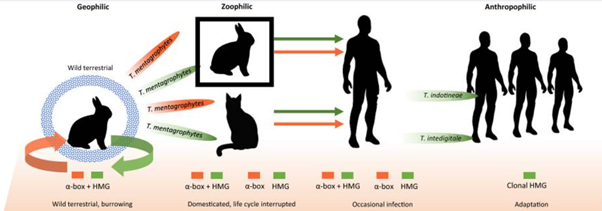
Image taken from Tang et al, 2021. Showing evolution of T. indotineae 
Two weeks growth of T. indotineae on SDA showing white-cream cottony to powdery colony with a yellow-white reverse. (image courtesy of A. Chowdhary) 
Two weeks growth of T. indotineae on SDA showing white-cream cottony to powdery colony with a yellow-white reverse. (image courtesy of A. Chowdhary) 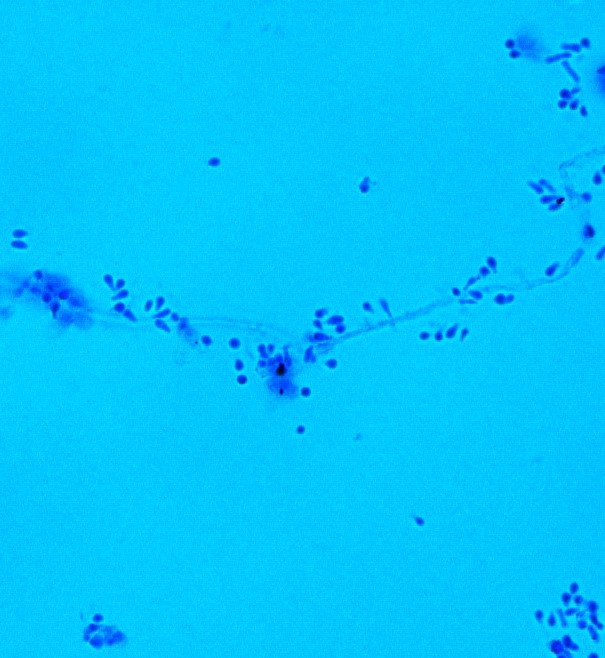
Lactophenol blue mount (40X) of T. indotineae showing sub-spherical to pyriform microconidia attached to the hyphae through narrow bases. (image courtesy of A. Chowdhary)
